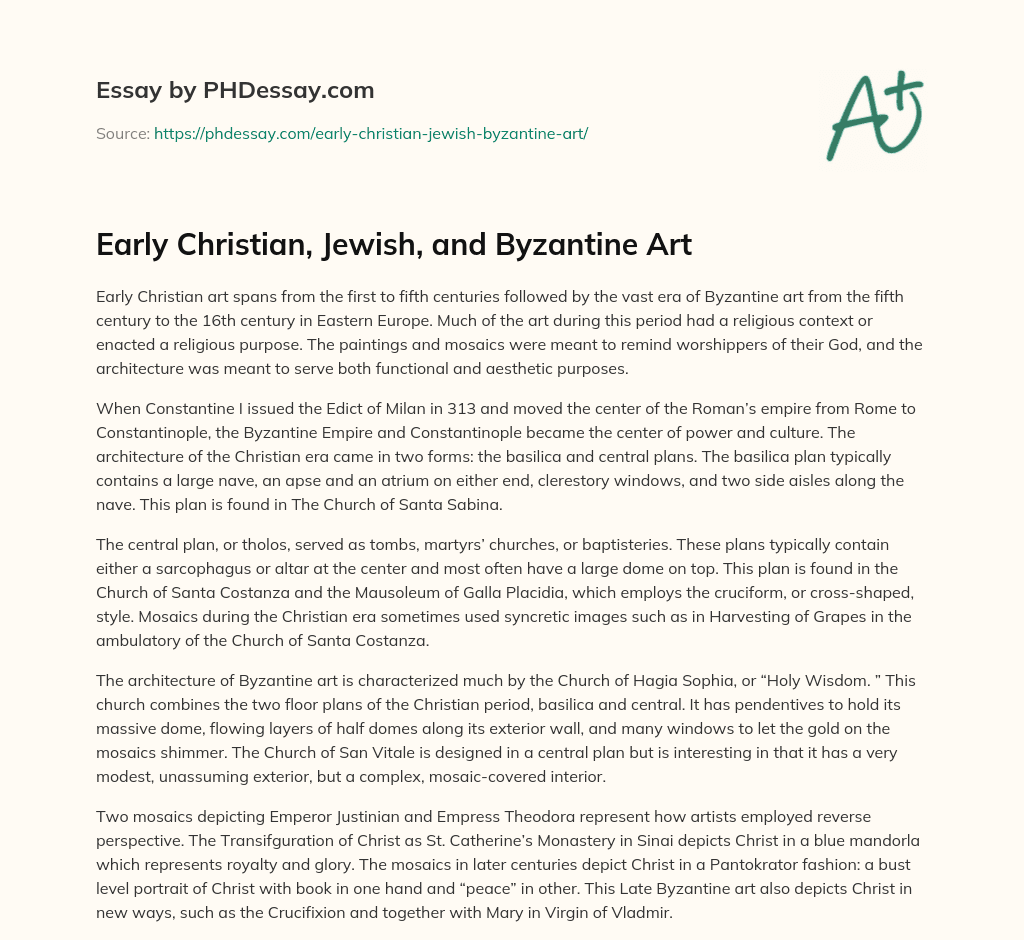How Did the Early Christian Life Develop Christian Art
Early Christian art ps from the get-go to 5th centuries followed past the vast era of Byzantine fine art from the fifth century to the 16th century in Eastern Europe. Much of the art during this period had a religious context or enacted a religious purpose. The paintings and mosaics were meant to remind worshippers of their God, and the architecture was meant to serve both functional and artful purposes.
When Constantine I issued the Edict of Milan in 313 and moved the center of the Roman'south empire from Rome to Constantinople, the Byzantine Empire and Constantinople became the eye of power and culture. The architecture of the Christian era came in two forms: the basilica and central plans. The basilica plan typically contains a big nave, an apse and an atrium on either end, clerestory windows, and two side aisles forth the nave. This program is institute in The Church of Santa Sabina.
The key programme, or tholos, served as tombs, martyrs' churches, or baptisteries. These plans typically contain either a sarcophagus or altar at the center and most often take a large dome on acme. This plan is establish in the Church of Santa Costanza and the Mausoleum of Galla Placidia, which employs the cruciform, or cross-shaped, style. Mosaics during the Christian era sometimes used syncretic images such every bit in Harvesting of Grapes in the ambulatory of the Church of Santa Costanza.
Order custom essay Early Christian, Jewish, and Byzantine Fine art with free plagiarism report
Become ORIGINAL Newspaper
The architecture of Byzantine art is characterized much past the Church of Hagia Sophia, or "Holy Wisdom. " This church combines the two flooring plans of the Christian period, basilica and central. It has pendentives to hold its massive dome, flowing layers of one-half domes along its exterior wall, and many windows to allow the gilt on the mosaics shimmer. The Church building of San Vitale is designed in a key program merely is interesting in that it has a very small-scale, unassuming outside, just a circuitous, mosaic-covered interior.
2 mosaics depicting Emperor Justinian and Empress Theodora represent how artists employed reverse perspective. The Transifguration of Christ equally St. Catherine's Monastery in Sinai depicts Christ in a blue mandorla which represents royalty and celebrity. The mosaics in later centuries describe Christ in a Pantokrator fashion: a bust level portrait of Christ with book in one hand and "peace" in other. This Late Byzantine fine art too depicts Christ in new means, such as the Crucifixion and together with Mary in Virgin of Vladmir.

Related Questions
on Early Christian, Jewish, and Byzantine Art
How did Christianity influence Byzantine art?
The purpose of Byzantine art was to glorify the Christian faith and to express its mystery. All of Byzantine art is filled with a kind of spiritual symbolism--things on globe are meant to represent the order of heaven. Another characteristic of the art of this rich empire is a love of splendor.
How is Christ portrayed in early Christian art?
Works of art were created primarily in the Christian catacombs of Rome, where early depictions of Christ portrayed him every bit the classical "Good Shepherd," a boyfriend in classical dress in a pastoral setting. At the aforementioned time, meaning was oft conveyed by symbols, and an early iconography began to develop.
What are some characteristics of early on Christian art?
Themes of death and resurrection. A striking aspect of the Christian art of the third century is the absence of the imagery that will boss later Christian art.Christianity's canonical texts and the New Testament. Early representations of Christ and the apostles.
What are some famous Byzantine art?
List of 10 Finest (Surviving) Examples of Byzantine ArtChrist Pantocrator, Hagia Sophia, Istanbul. Mosaic of Emperor Justinian I, Basilica of San Vitale, Ravenna. Enthroned Madonna with Child, the Saints Theodore and George, and Ii Angels, Saint Catherine'south Monastery. Theotokos of Vladimir, Tretyakov Gallery, Moscow. St Luke, Hosios Loukas, Distomo. Virgin with Child, Hagia Sophia, Istanbul.
Did you know that we have over 70,000 essays on 3,000 topics in our database?
Cite this page
Explore how the human torso functions equally one unit in harmony in society to life
Source: https://phdessay.com/early-christian-jewish-byzantine-art/
0 Response to "How Did the Early Christian Life Develop Christian Art"
Post a Comment